The Microwave Background and the Planck Mission |
|
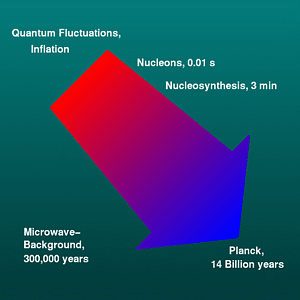
|
The Universe originated in a hot and dense state which is called
the "Big Bang". It expanded and subsequently cooled. When it had
reached a temperature of about 3000 K some 300000 years after the
Big Bang, electrons and nuclei could combine to form atoms. Almost
immediately the Universe became transparent. The light which also
originated in the Big Bang could from then on propagate almost
freely throughout the Universe. Because of the expansion of the
Universe, the wavelength of the light has by today been shifted
into the microwave regime around about a millimetre
wavelength. This light irradiates us almost isotropically as a
Cosmic Microwave Background. The Cosmic Microwave Background (CMB) is not exactly isotropic. The seeds of today's structures in the Universe imprinted tiny fluctuations on the CMB. These fluctuations were first detected by the American COBE satellite (below).
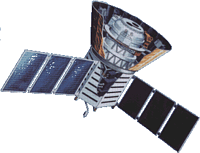
|
| COBE's angular resolution was rather poor, as it could only see structures on the sky larger than 7 degrees. However, the microwave background should exhibit much smaller structures. The two maps illustrate by means of a simulation how the CMB should look like with angular resolutions of 7 degrees (left) and 30 arc minutes (right). | |
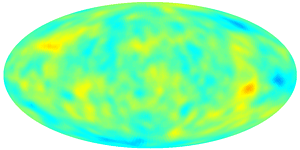
|
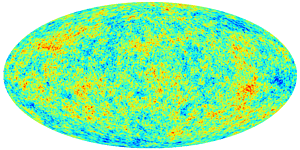
|
| It is of greatest interest for cosmology to accurately measure in particular the small structures in the microwave background. This is due to the fact that virtually all important quantities can be derived from them which determine the properties of the Universe at large. Among them are the mean matter density, the Hubble constant, the cosmological constant, the abundance of baryons (i.e. the building blocks of the nuclei) and several others. | |
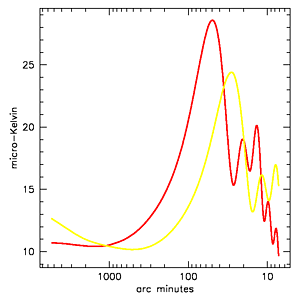
|
The figure to the left schematically shows how structures in the CMB can be described. The horizontal axis gives the angular size of structures in such a way that small structures are located to the right and large structures to the left. The vertical axis shows the typical amplitude of fluctuations of a given size. This amplitude is given in millionths of a degree (micro-Kelvins). The two curves show a very characteristic behaviour, in that a flat part to the left is followed by maxima and minima to the right, whose amplitude substantially decreases towards the right. The two curves were calculated for different cosmic matter density. They illustrate that the structures in the CMB depend sensitively on the cosmological parameters. |
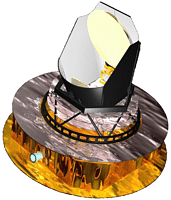
|
The Planck
satellite (the figure to the left shows a model) is the third
Medium-Sized Mission in the Horizon 2000 Scientific Programme of
the European Space Agency (ESA). Following its launch in 2007,
Planck will produce full-sky maps in nine frequency bands
in the microwave regime between 30 and 857 GHz. The primary goal
of the Planck Mission is to map the CMB with an angular
resolution of 5-10 arc minutes and a sensitivity of a millionth of
a degree, so that all relevant cosmological parameters can
accurately be determined from its structures. Furthermore,
Planck will test the inflationary model of the Universe,
and yield a wealth of information on other sources of microwave
emission in the Universe. Planck will revolutionise cosmology. The Mission will be the most important cosmological experiment for decades. Under the direction of ESA, Planck is being planned, developed and built by a consortium of European and North-American institutes. In that consortium, Germany is represented by MPA. Apart from other responsibilities, MPA will build up the archive for all final data products of the Planck Mission. A group of programmers and scientists works for the Planck Project at MPA. It is substantially supported by the Max-Planck Society (Max-Planck-Gesellschaft, MPG) and the German Space Agency (Deutsches Zentrum für Luft- und Raumfahrt, DLR). |
| MPA-Home |